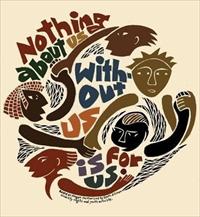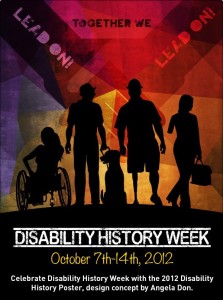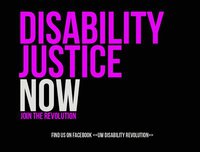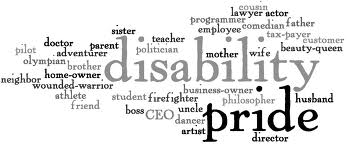Investigating Silences: A Review of “The Rhetoric of Ableism” by James L. Cherney
Rachel Cohen-Rottenberg
Union Institute & University
Spring-Summer semester, 2012
In his thought-provoking 2011 article, “The Rhetoric of Ableism,” James L. Cherney discusses the ways in which rhetoric creates and perpetuates the ideology of ableism, a set of beliefs and practices that make the able body the sine qua non of human worth and happiness. He argues that discrimination against disabled people is supported by the ways in which ableism is embedded in textual and visual representation, and that the project of deconstructing the rhetoric of ableism must take its place alongside activism that targets specific instances of discrimination. By analyzing ableist rhetoric, Cherney believes, scholars and activists can understand not only how ableism is perpetuated, but also how other forms of oppression are reinforced by similar tropes. He concludes that a thoroughgoing analysis of current rhetoric can result in neologisms that interrupt and transform ableist representations.
The author is an assistant professor in the Department of Communication at Wayne State University, where his areas of specialization include rhetoric and critical theory, particularly with reference to disability and the disability rights movement. In his article, he makes clear his desire to bring his expertise in the field of rhetoric to bear on the discrimination that disabled people face. Given that his interests are political, rhetorical, and ethical, he bases his analysis on the work of two thinkers whose interests mirror his own: Stuart Hall, a rhetorician concerned with the relationship between rhetoric and ideology (Makus 1990, 495), and Stephen Toulmin, a moral philosopher whose work focused, in part, on how human beings construct arguments (Stygall 1987, 96-98). Drawing from Hall’s definition of ideology as “the concepts and the languages of practical thought which stabilize a particular form of power and domination” (Hall 1996, 26, cited in Cherney 2011, 2), Cherney concerns himself with addressing the problem of how to critique ideological claims about disability that are considered self-evident and thereby outside the realm of rhetorical analysis. To address this issue, he begins with Toulmin’s definition of a “warrant” as a “self-authorizing statement” (Toulmin 1984, 46, cited in Cherney 2011, 5), and creates the concept of “rhetorical norms” — knowledge claims that are considered obvious and beyond analysis (Cherney 2011, 5). He then discusses three examples of widely accepted ableist rhetorical norms: “deviance is evil,” “body is able” (a reference to the notion that all ability resides in the body, rather than in the relationship between the body and the social/architectural environment), and “normal is natural” (Cherney 2011, 5-7).
As a writer interested in how language creates culture, a disability-rights activist whose primary mode of activism is the written word, and a person sensitive to the power of language, I am especially interested in the ways that Cherney articulates the problem of ableist thinking as rhetoric that poses as arhetorical, placing itself outside the realm of critique. In Cherney’s view, ableism is an exceptionally difficult ideology to name and to reject because it is “that most insidious form of rhetoric that has become reified and so widely accepted as common sense that it denies its own rhetoricity — it ‘goes without saying.’” (Cherney 2011, 2) For instance, in the minds of most people, it is simply a given that disabled people should become as able-bodied as possible. When attempting to critique such an idea, whose truth appears obvious, one comes up against charges of absurdity, as Cherney found when one of his professors attempted to dismiss his analysis of pervasive ableism with the retort “Next you’ll be telling me that those stairs discriminate!” (Cherney 2011, 4) Of course, the stairs do discriminate — against anyone who cannot walk. Moreover, Cherney addresses the ways in which purveyors of ableist rhetoric pose as value-neutral while leveling the accusation of partisanship at those who critique their rhetoric (Cherney 2011, 4) — a common experience for those of us who critique mainstream scientific or cultural work. I have often found myself stymied as to how to address rhetoric pretending to be above rhetoric; Cherney’s analysis is a reminder that, because all language supports ideological agendas and power relationships, the key is to a) critique how language works to uphold structures of power and b) create expressions that counter ableist representations.
With regard to creative expression, Cherney suggests that, in order to deconstruct ableism, it is not enough to engage in analysis; we must construct a new language. In a particularly apt turn of phrase, he writes, “Identifying ableism requires rhetorical invention, for to critique a rhetoric that goes without saying requires new words.” (Cherney 2011, 8 ) While Cherney lists a number of strategies that counter ableist tropes — disability narrative, critiques of mainstream cultural productions, new disability histories (Cherney 2011, 2) — he does not provide examples of what a new language might look like. However, he opens up the potential for new rhetoric by suggesting that, in our quest for a new language, we will uncover ableist rhetorical norms used against other minority groups (Cherney 2011, 10). While he does not follow up on the implications of analyzing the ways in which disability is deployed against other marginalized people, it seems to me that such a process can, indeed, lead us in the direction of creating the neologisms he hopes for.
Consider the parallels between cultural representations of genderqueer people and disabled people. In popular culture, genderqueer people are not only marginalized as a gender minority, but also by means of ableist rhetoric. For example, as discussed in the Questioning Transphobia piece “Radio Show Hosts Incite Abuse Against Trans Children,” a 2009 Sacramento, CA radio show featured two hosts referring to children with gender dysphoria as “idiots” and “freaks.” In coming up against this rhetoric, one might reflect on why it is used in this context. What is it about genderqueer and disabled people that brings out charges of freakishness? One area of commonality is that both groups are outside the easy dualisms that most people take for granted. Genderqueer people do not fit the gender binary, and this fact calls forth a great deal of hostility, as reflected by the responses to an article about “X” being added as a gender option on Australian passports. As noted in the article “Freaks and Perverts” on the A.E. Brain site, one reader said in response to the new category, “Male or female, that’s it! Don’t confuse yourself with another!” and a second said, “Sorry. Their [sic] are only two genders, male and female. Period. No debate. Deal with it.” This rejection of people who do not fit into an accepted dualistic paradigm brings to mind Robert Murphy’s analysis of the ways in which disabled people occupy a similarly liminal space in society at large, outside of the binaries that able-bodied people take for granted:
The long-term physically impaired are neither sick nor well, neither dead nor fully alive, neither out of society nor wholly in it… They are not ill, for illness is transitional to either death or recovery… The sick person lives in a state of social suspension until he or she gets better. The disabled spend a lifetime in a similar suspended state. They are neither fish nor fowl; they exist in partial isolation from society as undefined, ambiguous people (Murphy 1990, 131).
The fact that so many people feel such visceral discomfort and hostility toward anyone who goes outside of accepted dualisms raises the following questions: Would the problem be ameliorated by creating new language that is non-dualistic? Is it possible to create such language? Can we create new language that communicates ease with ambiguity and acceptance of paradox? And how might we critique the dualities in our own thinking?
Along these lines, it is worth pondering the ways in which Cherney helps to collapse the dualism between theory and practice. He is quite adamant in his view that theory — analyses of rhetoric and the ways in which ableism pervades our thinking — must be integrated into the disability rights struggle, for the simple reason that the ways in which we think about the world and the questions we ask determine the solutions we find. He makes an excellent case for combining the fight against specific instances of discrimination with the struggle against the views that inform them:
Because attacking the target requires forging coalitions with those who may oppose the target for other reasons, this strategically important move can actually help protect the underlying oppressive orientation from discovery, and eliminating the target can be confused with eliminating the oppressive view… Yet naming and calling into question the view itself raises the possibility of altering the very strands out of which the oppressive institutions are spun (Cherney 2011, 9).
Thus, in Cherney’s formulation, disability theory becomes an important component of the disability rights struggle — not simply a precursor or an academic exercise, but an integral part of the process. And certainly, the struggle itself generates its own theories and frameworks; after all, the social model of disability, a term coined in 1983, grew out of the activism of the Union of Physically Impaired Against Segregation (UPIAS) (Shakespeare 2010, 266). A dialectical view of the relationship between theory and practice reveals that practice generates theory, and that theory is part and parcel of practice.
Paradoxically, in its call for new kinds of rhetoric, Cheney’s analysis invites us to investigate the silences that surround the rhetoric we have. If ableist rhetoric is silent about the socially constructed nature of its assumptions, bringing those assumptions out into the open creates the possibility for speaking to the power relationships that underlie them. And given that ableist rhetoric attempts to silence its critics by diminishing their perspectives as partisan and absurd, we must consider all the ways to resist that silencing. Do we push up against it with words alone? With visual representation? Or do we simply assert the undeniable reality of our own bodies?
References
A.E. Brain. “Freaks and Perverts.” http://aebrain.blogspot.com/2011/09/freaks-and-perverts.html. September 15, 2011. Accessed April 23, 2012.
Cherney, James L. “The Rhetoric of Ableism.” Disability Studies Quarterly 31, no. 3 (2011). http://dsq-sds.org/article/view/1665/1606.
Hall, Stuart. “The Problem of Ideology: Marxism Without Guarantees.” In Critical Studies in Cultural Studies, edited by David Morley and Kuan-Hsing Chen, 24-45. London, England: Routledge, 1996.
Makus, Anne. “Stuart hall’s theory of ideology: A frame for rhetorical criticism.” Western Journal of Speech Communication 54, no. 4 (1990): 495-514. doi: 10.1080/10570319009374357.
Murphy, Robert Francis. The Body Silent. New York, NY: W.W. Norton & Company, Inc., 1990.
Questioning Transphobia. “Radio Show Hosts Incite Abuse Against Trans Children.” http://www.questioningtransphobia.com/?p=1443. June 3, 2009. Accessed April 23, 2012.
Shakespeare, Tom. “The Social Model of Disability.” In The Disability Studies Reader, edited by Lennard J. Davis, 266-273. New York, NY: Routledge, 2010.
Stygall, Gail. “Toulmin and the Ethics of Argument Fields: Teaching Writing and Argument.” Journal of Teaching Writing 6, no. 1 (1987): 93-107. http://journals.iupui.edu/index.php/teachingwriting/article/viewFile/835/807.
Toulmin, Stephen, Richard Rieke, and Allan Janik. An Introduction to Reasoning. New York, NY: Macmillan, 1984.
© 2012 by Rachel Cohen-Rottenberg








